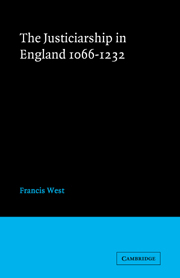Book contents
- Frontmatter
- Contents
- List of Abbreviations
- Introduction
- I THE ORIGINS OF THE JUSTICIARSHIP
- II THE JUSTICIARSHIP UNDER HENRY II
- III THE JUSTICIARSHIP UNDER RICHARD I
- IV THE JUSTICIARSHIP UNDER JOHN: BEFORE THE LOSS OF NORMANDY
- V THE JUSTICIARSHIP UNDER JOHN: AFTER THE LOSS OF NORMANDY
- VI THE JUSTICIARSHIP IN JOHN'S LAST YEARS
- VII THE JUSTICIARSHIP UNDER HENRY III
- Bibliography
- Index
I - THE ORIGINS OF THE JUSTICIARSHIP
Published online by Cambridge University Press: 08 January 2010
- Frontmatter
- Contents
- List of Abbreviations
- Introduction
- I THE ORIGINS OF THE JUSTICIARSHIP
- II THE JUSTICIARSHIP UNDER HENRY II
- III THE JUSTICIARSHIP UNDER RICHARD I
- IV THE JUSTICIARSHIP UNDER JOHN: BEFORE THE LOSS OF NORMANDY
- V THE JUSTICIARSHIP UNDER JOHN: AFTER THE LOSS OF NORMANDY
- VI THE JUSTICIARSHIP IN JOHN'S LAST YEARS
- VII THE JUSTICIARSHIP UNDER HENRY III
- Bibliography
- Index
Summary
The justiciar was the king's alter ego whose office met the need for an extension of the king's person and power, a need which came from two cardinal facts of English mediaeval history. The first was that the king personally ruled: he was himself the mainspring of government and his household or court the centre of power. The second was that the king was regularly and frequently abroad because England was part of a continental empire whose other dominions required the royal presence for their government in the same way that England did. Royal power had to be delegated at the highest level if government was to operate smoothly and not in fits and starts. Still, these two facts alone do not explain the justiciarship; they are necessary and not sufficient conditions. If the office be defined as a viceroyalty when the king was abroad, and a superintendence of the machinery of government whether he was abroad or not, then its creation was dependent on three other conditions: the evolution of a regular system of regency, the development of royal administration to the point at which a permanent superintendent was a great convenience or even a necessity, and the fusion of these two positions in a single office.
Such a definition, which is based on Angevin practice, can be used to answer the question: how and when did the justiciarship evolve? The emphasis placed on these different conditions has led historians to offer different answers.
- Type
- Chapter
- Information
- Justiceship England 1066–1232 , pp. 1 - 30Publisher: Cambridge University PressPrint publication year: 1966



